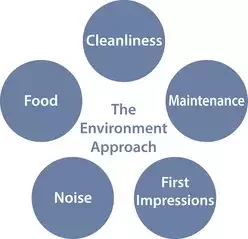
Halo Effect—Definition
The halo effect is a cognitive bias in which an observer's overall impression of a a team of 5 nurses and doctors standing and looking at the cameraperson, company, brand, or product influences their feelings and thoughts about that entity's character or properties.


The halo effect is an unconscious judgment. When we judge something, we run through a process of analysis and critical thinking; however, a significant part of the judgment is also performed unconsciously.
In hospitals, the halo effect of great nursing care is often discussed in relation to overall patient satisfaction. This is clearly true, since nursing staff will typically have the most interaction with patients. What is often lost in this discussion is that the patient notices and evaluates a great many environmental issues before any significant experience of nursing takes place.
Most patients cannot judge the quality of their medical care. All patient will judge the environment in which it is given.
Watch our 2.5 minute video that covers the basics of The Environment, one of the 9 Approaches to Improving Patient Satisfaction and Experience:
The Five Key Patient Satisfaction Strategies for Your Hospital Environment:
- Cleanliness
- Maintenance
- First Impressions
- Noise
- Food

1. Cleanliness


2. Maintenance
Ceiling tiles: We hear a lot about ceiling tiles, since the regulatory inspectors frequently complain about them. Don’t wait for the regulators before you put them right: your paying guests are going to spend a lot of time studying those stained dirty or loose tiles. This is one of the key cosmetic maintenance items.
Chipped Paintwork: Another key cosmetic item. Yes, the doors get hard traffic; yes, the rooms get knocked around by equipment and beds. You simply need to plan and staff the process adequately in order to provide the patient and visitor experience desired.

3. First Impressions

Furniture: Make sure all furniture is in good repair and looks good. Don’t tolerate tears or scratches.
Clutter: Ensure rooms are not overcrowded. Don’t just clear out the hallways when the regulators appear; make sure you have a strategy to keep them clear and calm all the time.
Art has a therapeutic impact for patients, visitors, and staff. The hospital’s approach to art needs to be well thought-out and managed over time. Invest in art work.
4. Noise
Staff: No staff on their breaks in public spaces.
Paging: No overhead paging; overall noise should be kept low.
Volume: Staff should use low voices.
Nursing: No audible nursing station-to-hallway discussions.
Visual Reader: Consider a visual decibel reader.
5. Food

Service: Just dropping off a meal tray is unacceptable. Set the table up, check that everything is OK with the patient, and so on. Their food must be delivered and presented as if they were in a top quality restaurant.
The hospital environment is 1 of The 17 Approaches to Improving Patient Satisfaction. Read about the rest of the approaches in this free eBook here.

